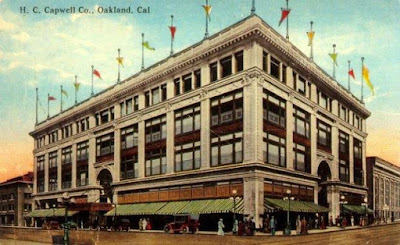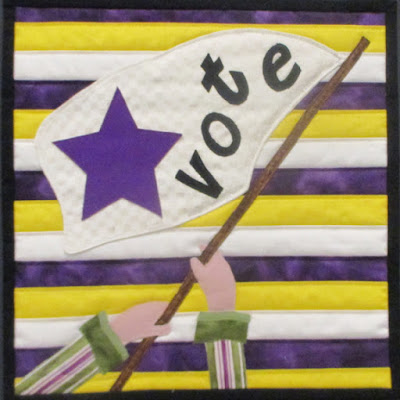The Lanford Album Quilt
Cargo Collection, Birmingham Museum of Art
Circa 1900?
Every time I post a picture of a patchwork flag I hear from those wondering if the maker ( block inscribed O.W.W.S. here) had reversed her flag to show distress. Another concern is that my picture is backwards, which it is not---O.W.W.S. wrote her S the correct direction.
1900 perhaps?
The field on the flag is on the right, an image found quite often in antique quilts.
From a quilt sold in an online auction from Massachusetts.
Silk flag in a crazy quilt about 1890
Many times the starry square is on the left as in this 1864 block in an album by
Mary Nevius Potter of New Jersey.
Crazy quilts often had small silk flags tacked down and embroidered.
If they were identical on the back and front you might tack them down either direction.
Quilt attributed to Martha Meeker, Connecticut
Directionality seems rather arbitrary. Quiltmakers showed the flag as viewed
from both sides.
Before the 1910s there was no "backwards."
So why do we think it's backwards?
My guess is a movement about 100 years ago to make "Flag Etiquette" into law. The American Legion, a new group of veterans of the European war, advocated many rules. The above advice for proper display is from one of their magazines in 1922.
On the list of "Don'ts" in that article they tell us:
"Don't sew the flag onto a sofa pillow."
Hey!
I collected these patriotic pillow covers for years and let me
tell you a lot of stitchers and commercial companies ignored that rule.
Library of Congress
The American Legion Women's Auxiliary was founded in 1919.
These groups emphasized teaching flag etiquette in schools.
Rules from an Oklahoma teachers' periodical in the early 1920s.
"The flag must not be used in whole or in part as a costume...."
1928
Another rule people were only too glad to ignore.
"nor may it be used as a toy, fan, parasol, paper napkin or sofa cushion."
The are no penalties for using a flag as a paper napkin or putting it on a pillow.
So who were the arbitrators who wrote so many rules?
The American Legion, still active, tells us:
"On Flag Day, June 14, 1923, The American Legion and representatives of 68 other patriotic, fraternal, civic and military organizations met in Washington, DC for the purpose of drafting a code of flag etiquette. The 77th Congress adopted this codification of rules as public law on June 22, 1942."
Other patriotic organizations supported rules, advocating legislation of flag etiquette. In 1924 the Daughters of 1812 published a pamphlet encouraging laws prohibiting "printing or letters on any kind of Flag."
Political flag of the 1840s
Ohio Daughters in the teens
The Daughters of the American Revolution have been handing out Flag Code leaflets at least since the 1920s. During World War I the DAR lobbied to get an "Iowa Flag Law" enacted. One goal was to remove a floor design depicting the American flag in the state capitol building in Des Moines.
Floor under the rotunda
Apparently they succeeded in 1915 as there is a large glass circle on the floor today (recently replaced) and no memory of any flag today.
More outrage occurred at the Iowa State Fair that year when a quilt with a woven flag design was exhibited. The state Attorney General's office declared it a violation and shipped the quilt back to the man who made it (a penitentiary inmate---apparently a hopeless recidivist.)
From an album quilt in the Pat Nickols Collection at the Mingei Museum
So why do we think the field on the right is wrong?
I guess it's because those of us raised in the nationalistic post-World War II classroom were eager to follow the rules. And there were people eager to make them up.

Mary Maxtion, Greene County, Alabama
Cargo Collection at the International Quilt Museum



























































